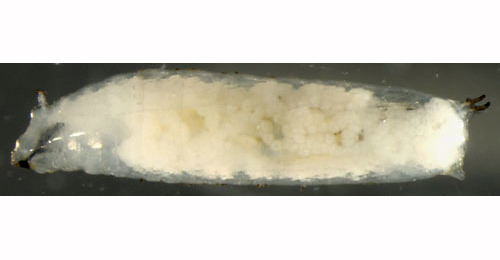|
||||||
|
Chromatomyia
lonicerae (Robineau-Desvoidy, 1851) Phytomyza
lonicerae Robineau-Desvoidy, 1851. Rev. Mag. Zool. (2) 3: 396 |
|||||||||||||||||||||||||||||||||||||||||||||||||||||||||||||||||||||||||||||||||||||||||||||||||||||||||||||||
|
Leaf-miner: Mine an irregular stellate blotch with a later linear section. Pupation internal; firmly glued within the mine by frass (Spencer, 1976: 443). The mine begins with a few lower-surface corridors, radiating from one centre that is not associated with the midrib; the corridors are very shallow and not easy to observe. Subsequently some (rarely only one) upper-surface, rather long and often branched corridors are formed from the same centre. Frass mostly at one side, in pearl chains. Pupation within the mine (Bladmineerders van Europa). An upper surface gallery with a star-shaped start. Frass in pearl-strings (British leafminers). Larva: The larvae of flies are leg-less maggots without a head capsule (see examples). They never have thoracic or abdominal legs. They do not have chewing mouthparts, although they do have a characteristic cephalo-pharyngeal skeleton (see examples), usually visible internally through the body wall. The larva is illustrated in Bladmineerders van Europa.
Puparium: The puparia of flies are formed within the hardened last larval skin or puparium and as a result sheaths enclosing head appendages, wings and legs are not visible externally (see examples). Yellowish or reddish brown; posterior spiracles are elongate, with up to 24 bulbs (Spencer, 1976: 443). The anterior spiracles of the puparium penetrate the plant epidermis (Bladmineerders van Europa). Hosts in Great Britain and Ireland:
Hosts elsewhere:
Time of year - mines: May-August, November. Time of year - adults: July-August. Single generation. Distribution in Great Britain and Ireland: Widespread in Britain including Inner Hebrides (Isle of Coll) (Bland, 1992); Warwickshire (Coventry) (Robbins, 1991: 107); Anglesey, Caernarvonshire, Denbighshire, East Gloucestershire, East Norfolk, East Ross, East Sussex, East Sutherland, Flintshire, Glamorgan, Herefordshire, Kirkudbrightshire, Main Argyll, Merionethshire, Mid-west Yorkshire, Montgomeryshire, North Ebudes, North Somerset, Outer Hebrodes, Pembrokeshire, Shropshire, South Lancashire, South-west Yorkshire, Stafford, Surrey, West Gloucestershire, West Lancashire, West Ross and Westmorland (NBN Atlas). Mines from Sutherland (Golspie) (Spencer, 1972b) may refer to Aulagromyza hendeliana or to Chromatomyia lonicerae. Also recorded in the Republic of Ireland (Fauna Europaea). Distribution elsewhere: Widespread in much of Europe, including Denmark, Finland, Norway, Sweden (Spencer, 1976: 441), The Netherlands, Luxembourg (Bladmineerders van Europa), Belgium (de Bruyn and von Tschirnhaus, 1991), Germany (Spencer, 1976: 574), Austria, Corsica, Czech Republic, French mainland, Italian mainland, Lithuania and Poland (Fauna Europaea). NBN Atlas links to known host species:
British and Irish Parasitoids in Britain and elsewhere: |
| Last updated 09-Jul-2019 Brian Pitkin | ||

